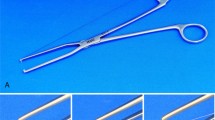Abstract
Background
The application of transseptal suturing as an alternative to intranasal splints in preventing postoperative complications, such as synechia, and maintaining nasal septal stability following Septoplasty, remains controversial. This meta-analysis aims to systematically compare the effectiveness and safety of transseptal suturing with intranasal splints after Septoplasty.
Methods
A comprehensive systematic literature review based on the Preferred Reporting Items for Systematic Reviews and Meta-Analyses (PRISMA) guidelines was conducted. The review included randomized clinical trials (RCTs) identified through a database search in July 2023, comparing postoperative complications following Septoplasty with the transseptal suturing technique versus intranasal splints.
Results
Eight published RCTs involving 570 participants were included in the meta-analysis. The analysis revealed no significant difference between the transseptal suturing and intranasal splint techniques following Septoplasty in postoperative complications, including postoperative hemorrhage, synechia, septal hematoma, septal perforation, local infection, crusting, and residual septal deviation.
Conclusions
Transseptal suturing can be applied following Septoplasty as an alternative to intranasal splints without increasing the rate of postoperative complications.
Level of Evidence I
This journal requires that authors assign a level of evidence to each article. For a full description of these Evidence-Based Medicine ratings, please refer to the Table of Contents or the online Instructions to Authors www.springer.com/00266











Similar content being viewed by others
Change history
13 June 2024
A Correction to this paper has been published: https://doi.org/10.1007/s00266-024-04177-w
References
Ivanova PP, Iliev G (2023) Nasal packing in septal surgery: a narrative review. Cureus 15:1–4
Li H, Wang M, Wu Y-X et al (2017) Nasal septum suture combined with inferior turbinate coblation after septoplasty: Does it improve quality of life and reduce complications? World J Otorhinolaryngol Head Neck Surg 3:44–48
Lau J, Elhassan HA, Singh N (2018) History of intranasal splints. J Laryngol Otol 132:198–201
Rechtweg JS, Paolini RV, Belmont MJ, Wax MK (2001) Postoperative antibiotic use of septoplasty: a survey of practice habits of the membership of the American Rhinologic Society. Am J Rhinol 15:315–320
Sessions RB (1984) Membrane approximation by continuous mattress sutures following septoplasty. Laryngoscope 94:702–703
Hari C, Marnane C, Wormald PJ (2008) Quilting sutures for nasal septum. J Laryngol Otol 122:522–523
Kuboki A, Kikuchi S, Asaka D et al (2018) Nasal silicone splints and quilting sutures using a septum stitch device following septoplasty: a prospective comparative study. Eur Arch Otorhinolaryngol 275:1803–1809
Hutton B, Salanti G, Caldwell DM et al (2015) The PRISMA extension statement for reporting of systematic reviews incorporating network meta-analyses of health care interventions: checklist and explanations. Ann Intern Med 162:777–784
Alrfooh AA, Alkrymeen MMA, Mohammad A et al (2022) Quilting suture versus silastic intranasal septal splint in septoplasty. J R Med Serv 29:1–7
Cayonu M, Acar A, Horasanlı E et al (2014) Comparison of totally occlusive nasal pack, internal nasal splint, and transseptal suture technique after septoplasty in terms of immediate respiratory distress related to anesthesia and surgical complications. Acta Otolaryngol 134:390–394
Özkırış M, Kapusuz Z, Saydam L (2013) Comparison of nasal packs with transseptal suturing after nasal septal surgery. Am J Otolaryngol 34:308–311
Sari K, Gul AI, Kantekin Y et al (2017) Transseptal suturing reduce patient anxiety after septoplasty compared to nasal packing. Acta Med 59:133–136
Ardehali MM, Bastaninejad S (2009) Use of nasal packs and intranasal septal splints following septoplasty. Int J Oral Maxillofac Surg 38:1022–1024
Baklaci D, Güler İ, Kuzucu İ et al (2019) Comparison of the transseptal suturing with nasal packs after septoplasty. Balıkesir Med J 3:90–101
Soni S (2020) A comparative study of occlusive nasal packs, internal nasal splints and transseptal suture techniques after septoplasty. IOSR J Dental Med Sci 19:30–41
Kim SJ, Chang DS, Choi MS et al (2021) Efficacy of nasal septal splints for preventing complications after septoplasty: a meta-analysis. Am J Otolaryngol 42:102389
Korkut AY, Teker A, Eren SB et al (2010) A randomised prospective trial of trans-septal suturing using a novel device versus nasal packing for septoplasty. Rhinology 48:179–182
Funding
No funding was received for this study.
Author information
Authors and Affiliations
Corresponding author
Ethics declarations
Conflict of interest
The authors declare that they have no conflicts of interest to disclose.
Ethical Approval
This article does not contain any studies with human participants or animals performed by any of the authors.
Informed Consent
For this type of study, informed consent is not required.
Additional information
Publisher's Note
Springer Nature remains neutral with regard to jurisdictional claims in published maps and institutional affiliations.
Rights and permissions
Springer Nature or its licensor (e.g. a society or other partner) holds exclusive rights to this article under a publishing agreement with the author(s) or other rightsholder(s); author self-archiving of the accepted manuscript version of this article is solely governed by the terms of such publishing agreement and applicable law.
About this article
Cite this article
Aldhwaihy, L., Alhazzani, H. & Alkarzae, M. Comparison on the Effectiveness and Safety of Transseptal Suturing Versus Intranasal Splints After Septoplasty: A Systematic Review and Meta-analysis. Aesth Plast Surg (2024). https://doi.org/10.1007/s00266-024-04066-2
Received:
Accepted:
Published:
DOI: https://doi.org/10.1007/s00266-024-04066-2




